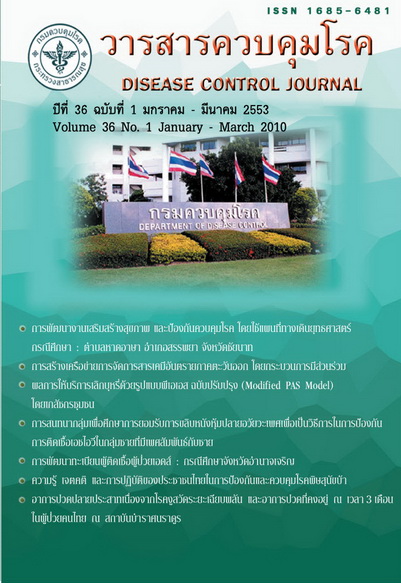Knowledge, Attitude and Practice of Thai People in Prevention and Control of Rabies
Keywords:
Knowledge, Attitude and Practice, Prevention and Control of Rabies, Thai PeopleAbstract
This study was a KAP survey. Data were collected by interviewing heads or members of households over 15 years old about prevention and control of rabies in animals and humans. Multistage sampling identified 5,398 interviewers in 24 provinces; Pathum Thani, Ayutthaya, Sara buri, Ang Thong, Sa Kaeo, ChonBuri, Nakhon Pathom, Phetchaburi, Surin, Chaiyaphum, Nong Khai, Roi Et, Mukdahan, Sakon Nakhon, Nakhon Sawan, Phichit, Phitsanulok, Tak, Chiang Mai, Phayao, Nakhon Si Thammarat, Surat Thani, Songkhla, and Phatthalung. Interview data were analyzed, expressed in percentage and tested by Chi-square. The study showed that most households kept dogs or cats, and keeping more dogs than cats. Majority of the households kept dogs for house guarding and as pets. Dogs were kept as pets more in the central region than in other regions. Dogs were mostly left free inside or outside the houses. 11.9% of the households reported a member bitten by a dog or cat in the past one year. Most of these were bitten by dogs and 75% of the victims saw the doctor after the bite. Most of the bites were made by own dogs. For people did not see the doctor after dog bites because they thought that small bites or the bites of baby dogs had low risk of rabies. The reasons for lack of vaccination in dogs and cats included lack of vaccination services, the animals were young (under 2 months), and the animals could not be caught for vaccination. In addition, the people were found to have incorrect knowledge about rabies signs in suspected animals, types of animals that may carry rabies, treatment of rabies patients, management of rabies-risk bites, and existence of the laws that mandate vaccination of owned dogs. Only 25% of people aged 76-90 years old were bitten by animals saw the doctor for treatment. Medical treatment seeking rate was lowest in the central region. The outcome of this study suggested improvement of rabies risk communication with emphases on disease severity, dog vaccination, avoidance of dog bites and proper management of animal bites. Vaccination service for animals should be strengthened.
Downloads
References
2. อภิรมย์ พวงหัตถ์, วิรงรอง หุ่นสุวรรณ. สถานการณ์ โรคพิษสุนัขบ้าในประเทศไทย. จดหมายเหตุการแพทย์2548; 88(9):1319-1322.
3. สำนักระบาดวิทยา กรมควบคุมโรค. สรุปรายงานการเฝ้าระวังโรค สำนักพิมพ์องค์การรับส่งสินค้าและพัสดุภัณฑ์ กรุงเทพมหานคร, 2548.
4. สุรชัย ศิลาวรรณ และคณะ. ศึกษาการจัดการป้องกันโรคพิษสุนัขบ้าและความเสี่ยงต่อการเกิดโรคหลังถูกสัตว์กัด ของประชากรในพื้นที่เขตตรวจราชการที่ 13 . สำนักงานป้องกันควบคุมโรคที่ 5 นครราชสีมา. 2551.
5. ชัยณรงค์ อภิณหพัฒน์ และคณะ. ความรู้เรื่องโรคพิษสุนัขบ้าของเจ้าหน้าที่องค์กรปกครองท้องถิ่นในพื้นที่สาธารณสุขเขต 1 ปี 2543. วารสารสำนักงานควบคุมโรคติดต่อเขต 1 กรุงเทพฯ 2544; 5: 16-17.
6. มนจิรา ถมังรักษ์สัตว์ และพัชนี ศิริสุนทร. ปัจจัยที่มีอิทธิพลต่อพฤติกรรมการป้องกันโรคพิษสุนัขบ้าของหัวหน้าครัวเรือน จังหวัดปทุมธานี, 2542.
Downloads
Published
How to Cite
Issue
Section
License
Articles published in the Disease Control Journal are considered as academic work, research or analysis of the personal opinion of the authors, not the opinion of the Thailand Department of Disease Control or editorial team. The authors must be responsible for their articles.






